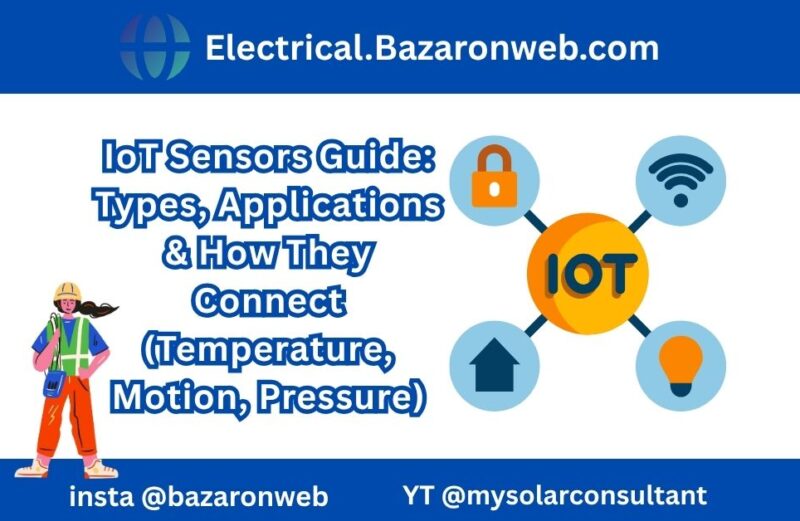For many of our industrial projects we have installed IoT sensors. If you have a farm and want to pick data like Soil Humidity, Temperature, Total Sunlight Hours etc. you can install some sensors there and publish data to a server.
The Internet of Things (IoT) has transformed how we interact with the physical world. From smart homes to industrial automation, IoT sensors are at the heart of this revolution. These small but powerful devices collect and transmit data — enabling machines, systems, and even entire cities to make intelligent decisions.
In this guide, we’ll explore the most common types of IoT sensors, their real-world applications, and how they connect to the internet to create seamless, automated ecosystems.
🔍 What Are IoT Sensors?
IoT sensors are physical devices that detect and measure changes in the environment — such as temperature, motion, pressure, humidity, or light — and convert this data into digital signals for analysis and action.
They are key to enabling machines to “sense” their surroundings and respond accordingly. In most IoT systems, these sensors are connected to a central processor or the cloud via wired or wireless networks.
📦 Types of IoT Sensors
Here are the most commonly used sensors in IoT devices:
1. Temperature Sensors
- Purpose: Measure heat or cold levels in an environment.
- Common Applications:
- Smart thermostats (e.g., Nest)
- Cold chain monitoring in logistics
- HVAC systems
- Industrial temperature control
2. Motion Sensors
- Purpose: Detect movement or physical activity.
- Types: PIR (Passive Infrared), Ultrasonic, Microwave
- Common Applications:
- Security systems and surveillance
- Smart lighting (auto on/off based on motion)
- Fitness trackers and smartwatches
- Intrusion detection
3. Pressure Sensors
- Purpose: Measure force per unit area, especially air or fluid pressure.
- Common Applications:
- Tire pressure monitoring in vehicles
- Industrial gas systems
- Weather stations
- Smart water and oil pipelines
4. Humidity Sensors
- Purpose: Measure the moisture level in air.
- Common Applications:
- Agriculture and greenhouses
- HVAC control
- Smart indoor air quality monitors
5. Proximity Sensors
- Purpose: Detect the presence or absence of an object without physical contact.
- Common Applications:
- Touchless faucets and dispensers
- Inventory tracking in warehouses
- Parking sensors in vehicles
6. Light Sensors
- Purpose: Detect ambient light levels.
- Common Applications:
- Automatic brightness adjustment in phones
- Smart streetlights
- Energy-efficient buildings
7. Gas and Air Quality Sensors
- Purpose: Monitor the presence of gases like CO₂, CO, methane, etc.
- Common Applications:
- Air purifiers and ventilation control
- Industrial safety monitoring
- Smart homes and buildings
🧠 How IoT Sensors Work: From Detection to Decision
Here’s a simplified breakdown of the sensor-to-action cycle in an IoT system:
- Sensing: The sensor detects a specific environmental condition (e.g., temperature exceeds 30°C).
- Data Transmission: The sensor sends this data to a microcontroller or gateway device.
- Processing: The data is analyzed locally (edge computing) or sent to the cloud for processing.
- Action/Alert: Based on rules or AI algorithms, a decision is made — e.g., turn on the air conditioner or send an alert.
📡 How IoT Sensors Connect: IoT Connectivity Explained
One of the most important aspects of IoT is how sensors communicate. Here are the most common connectivity options:
🔌 Wired Connections
- Ethernet, RS-232, RS-485: Used in industrial settings for stable connections and fast data transfer.
📶 Wireless Connections
- Wi-Fi: Ideal for home or office networks; high bandwidth but limited range.
- Bluetooth/BLE (Low Energy): Great for short-range communication and battery efficiency.
- Zigbee & Z-Wave: Popular in smart homes for low-power, mesh networking.
- LoRaWAN: Long-range, low-power protocol used in agriculture, smart cities.
- NB-IoT / LTE-M: Cellular-based options for wide-area coverage with low power usage.
☁️ Cloud Integration
- Many IoT systems use cloud platforms (like AWS IoT, Azure IoT Hub, or Google Cloud IoT) for storage, analysis, and control.
🌍 Real-World Applications of IoT Sensors
IoT sensors are used across almost every industry. Here’s how:
🏠 Smart Homes
- Temperature sensors adjust thermostats.
- Motion sensors turn on lights.
- Air quality sensors control purifiers.
🏭 Smart Industry (IIoT)
- Pressure and temperature sensors maintain machine safety.
- Vibration sensors detect early signs of mechanical failure.
- Sensors feed into predictive maintenance systems.
🚚 Logistics & Supply Chain
- GPS and motion sensors track shipments.
- Temperature sensors ensure cold chain integrity.
- Pressure sensors monitor package handling.
🚜 Smart Agriculture
- Soil moisture and humidity sensors guide irrigation.
- Weather sensors optimize planting and harvesting.
- Pest detection sensors reduce chemical usage.
🏙️ Smart Cities
- Light sensors automate street lighting.
- Noise and pollution sensors monitor urban environments.
- Traffic flow sensors improve signal timing and reduce congestion.
🔐 Security & Privacy Considerations
With the rise of sensor-based systems, data privacy and cybersecurity become crucial:
- Always use encrypted communication (TLS/SSL).
- Regularly update firmware and apply security patches.
- Avoid default passwords on IoT devices.
✅ Final Thoughts
IoT sensors are the backbone of modern smart systems. By detecting changes in the physical world and connecting that data to cloud or edge computing platforms, they enable intelligent automation, efficiency, and safety.
Understanding the types of sensors, how they connect, and where they’re used can help businesses and homeowners alike make smarter technology decisions. Whether you’re optimizing a smart home, launching an industrial project, or building a smart city solution — sensors are where it all begins.

